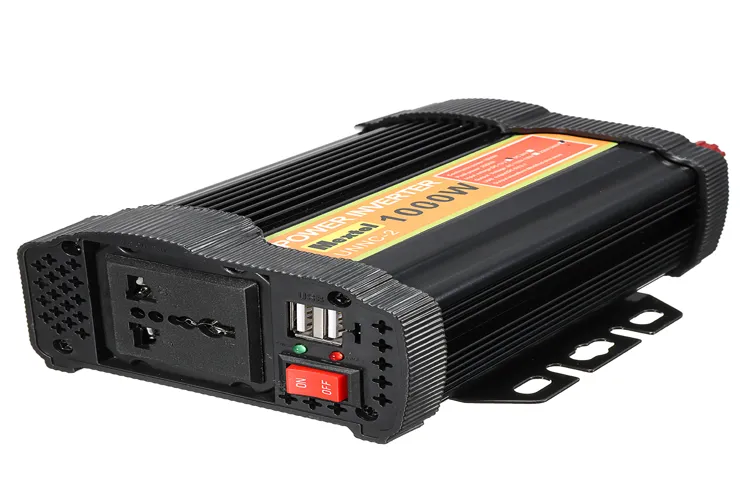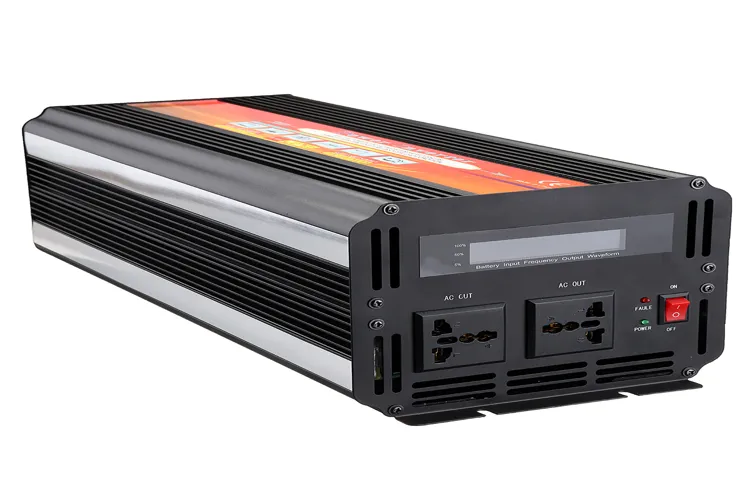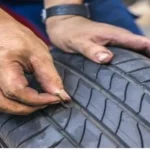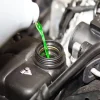Welcome to the world of solar power inverters! If you’re curious about how solar energy is converted into usable electricity for your home or business, you’ve come to the right place. Solar power inverters play a crucial role in this process, transforming the direct current (DC) energy generated by solar panels into alternating current (AC) energy that can power your devices and appliances. Think of solar power inverters as the translators that bridge the gap between your solar panels and your electrical system.
Just like how a translator helps you communicate with someone who speaks a different language, the solar power inverter ensures that the electricity produced by your solar panels is compatible with the electrical system in your home or business. But how exactly does it work? Solar power inverters harness the power of sophisticated electronics to perform this conversion. They receive the DC energy from the solar panels and use advanced circuitry to convert it into AC energy that matches the voltage and frequency requirements of your electrical system.
Not only do solar power inverters convert the energy, but they also play a vital role in optimizing its performance. Most solar power inverters come equipped with smart features that monitor the performance of your solar panels and adjust their operation accordingly. This ensures that you get the maximum energy output from your solar system, even in less-than-ideal conditions.
In addition to their role as translators and optimizers, solar power inverters also provide important safety features. They have built-in protection mechanisms that safeguard your electrical system from overvoltage, overcurrent, and other potential issues. This ensures that your solar energy system operates safely and reliably.
So, whether you’re considering installing a solar energy system or simply want to understand how solar power works, learning about solar power inverters is a great place to start. In our upcoming blog posts, we’ll dive deeper into the different types of solar power inverters, their features, and how to choose the right one for your specific needs. Stay tuned to unlock the full potential of solar power!
Table of Contents
What is a Solar Power Inverter?
So, you’re interested in solar power and have heard the term “solar power inverter,” but you’re not quite sure what it is. Well, let me break it down for you in simple terms. A solar power inverter is an essential component of a solar energy system that converts the direct current (DC) electricity generated by solar panels into alternating current (AC) electricity that can be used to power your home or business.
Think of it as the translator between the solar panels and your electrical appliances. It takes the energy captured by the panels and converts it into a form that can be used to power your lights, appliances, and everything else that requires electricity. Without a solar power inverter, the DC electricity produced by the solar panels would be useless to you.
So, it’s a crucial piece of equipment if you want to harness the power of the sun and reduce your reliance on fossil fuels.
Definition of a Solar Power Inverter
solar power inverter, inverters, renewable energy, solar panels, electricity Content: What is a solar power inverter? Well, imagine you have a solar panel system installed on your roof. Those solar panels are great at capturing sunlight and converting it into electricity. But how do you use that electricity to power your household appliances or feed it back into the grid? That’s where the solar power inverter comes in.
A solar power inverter is a device that converts the direct current (DC) electricity generated by solar panels into alternating current (AC) electricity that can be used by your household appliances or fed back into the electrical grid. Essentially, it takes the energy harnessed by the solar panels and transforms it into a form that is compatible with the standard electrical system in your home. Think of the solar power inverter as a translator or a bridge between your solar panels and the appliances in your home.
It ensures that the electricity generated by the solar panels is in a usable form, allowing you to power your lights, appliances, and electronics with clean and renewable energy. In addition to converting DC electricity into AC electricity, solar power inverters also play a crucial role in monitoring and managing the performance of your solar panel system. They can provide real-time data on the energy production of your panels, track any potential issues or disruptions in the system, and even optimize the energy output for maximum efficiency.
So, whether you’re looking to power your home with solar energy or simply want to reduce your carbon footprint, a solar power inverter is an essential component of any solar panel system. It not only converts the energy from the sun into usable electricity but also ensures that your system operates efficiently and effectively. With a solar power inverter, you can harness the power of the sun and enjoy the benefits of renewable energy.

How Does a Solar Power Inverter Work?
solar power inverter, solar inverter, solar panel, renewable energy, electricity, direct current (DC), alternating current (AC), power conversion. What is a Solar Power Inverter? A solar power inverter is a critical component in a solar panel system that converts the direct current (DC) electricity generated by the solar panels into usable alternating current (AC) electricity. Since most of our appliances and devices run on AC power, the inverter plays a crucial role in making the solar electricity usable for our everyday needs.
Think of it as a translator that takes the language of the sun (DC) and translates it into a language that our homes and businesses can understand (AC). The solar inverter is responsible for the conversion process and ensures that the electricity flowing through our solar panels can be utilized efficiently. Without it, we wouldn’t be able to power our homes and businesses with clean, renewable energy from the sun.
Types of Solar Power Inverters
A solar power inverter is a crucial component of a solar energy system that converts direct current (DC) electricity generated by solar panels into alternating current (AC) electricity that can be used to power homes and businesses. Without an inverter, the DC electricity produced by solar panels would not be compatible with the electricity grid or household appliances. There are several types of solar power inverters available on the market, each with its own unique features and advantages.
String inverters are the most common type and are connected to a string of solar panels. They are cost-effective and easy to install, but if one panel in the string underperforms, it can affect the performance of the entire string. Microinverters, on the other hand, are installed on each individual solar panel, allowing for independent operation and increased energy production.
Although more expensive upfront, microinverters can optimize the output of each panel and can be more reliable in the long term. Power optimizers are another option, which optimize the performance of each panel in a similar way to microinverters. They are installed at the panel level, but the DC electricity is still converted to AC at a centralized inverter.
This offers a balance of cost-effectiveness and optimization. Finally, hybrid inverters combine a solar power inverter with a battery storage system, allowing for energy to be stored and used during times when the sun is not shining. These inverters are ideal for homeowners looking to maximize their self-consumption and reduce reliance on the grid.
Overall, the choice of solar power inverter will depend on factors such as budget, system size, and desired functionality.
String Inverters
string inverters, types of solar power inverters
Microinverters
microinverters, types of solar power inverters
Central Inverters
types of solar power inverters
Benefits of Solar Power Inverters
A solar power inverter is an essential component of a solar energy system that converts the direct current (DC) electricity generated by the solar panels into alternating current (AC) electricity that can be used to power household appliances and electrical devices. It acts as the bridge between the solar panels and the electrical grid, ensuring that the electricity produced is compatible with the existing power grid. Without a solar power inverter, the DC electricity generated by the solar panels would not be usable in a typical home or business.
In addition to converting the electricity, solar power inverters also optimize the output of the solar panels and monitor the performance of the system. They can also provide important information about the solar energy system’s energy production, allowing homeowners to track their energy savings and environmental impact. Overall, solar power inverters play a crucial role in maximizing the efficiency and effectiveness of a solar energy system.
Conversion of DC to AC Power
solar power inverters
Grid-Tied Systems
solar power inverters
Considerations When Choosing a Solar Power Inverter
A solar power inverter is an essential component of a solar panel system. It is responsible for converting the direct current (DC) electricity generated by the solar panels into alternating current (AC) electricity that can be used to power appliances and devices in your home or business. Without an inverter, the electricity produced by the solar panels would not be compatible with the electrical grid or household appliances.
When choosing a solar power inverter, there are several important considerations to keep in mind. One of the main factors to consider is the size or capacity of the inverter. It should be able to handle the maximum power output of your solar panels.
Additionally, you should consider the efficiency of the inverter, as this will affect the overall energy production of your solar system. Other factors to consider include the type of inverter (string inverter, micro inverter, or power optimizer), the warranty offered by the manufacturer, and the compatibility of the inverter with other components of your solar system. By carefully considering these factors, you can choose the right solar power inverter for your specific needs.
System Size and Power Output
solar power inverter, system size, power output In the world of solar power systems, choosing the right inverter is key to maximizing the efficiency and performance of your system. When it comes to system size and power output, there are a few considerations to keep in mind. First and foremost, your solar power inverter should be properly sized to match the capacity of your solar panels.
This ensures that you’ll be able to take full advantage of the power generated by your panels and minimize any potential losses. Additionally, it’s important to consider the power output of the inverter. A higher power output can provide more flexibility when it comes to expanding your solar system in the future.
In some cases, you may even want to consider oversizing your inverter to allow for future upgrades. By choosing a solar power inverter that matches the system size and provides an adequate power output, you’ll be well on your way to harnessing the full potential of solar energy.
Efficiency and Conversion Rate
solar power inverter, efficiency, conversion rate
Installation and Maintenance
solar power inverter, installation, maintenance Are you looking to harness the power of the sun with a solar power system? One important component you’ll need to consider is the solar power inverter. This device is responsible for converting the direct current (DC) generated by your solar panels into alternating current (AC) that can be used to power your home or business. Choosing the right solar power inverter is crucial for the efficiency and performance of your solar system.
There are a few key factors you should consider when making your decision. The first consideration is the type of inverter you need. There are three main types: string inverters, microinverters, and power optimizers.
String inverters are the most commonly used and are cost-effective for small to medium-sized installations. Microinverters are installed on each individual solar panel and allow for maximum system efficiency, but they can be more costly. Power optimizers are a compromise between the two, offering some of the benefits of microinverters while still using a string inverter.
Consider your system size, budget, and desired level of system performance when choosing the type of inverter. Another important factor to consider is the inverter’s power rating. This refers to the maximum amount of power the inverter can handle.
It should be matched to the size of your solar system to ensure optimal performance. If the inverter is undersized, it may not be able to handle the power output of your panels, resulting in a decrease in system efficiency. On the other hand, if the inverter is oversized, it may be more expensive and unnecessary for your system.
It’s important to consult with a professional to determine the right power rating for your specific needs. The inverter’s efficiency is another consideration. This refers to how well it can convert DC power to AC power.
Conclusion
In conclusion, a solar power inverter is like the Tony Stark of the solar energy world. It takes the raw power of the sun and transforms it into a form that our homes and devices can use, just like Iron Man harnesses his genius and transforms it into a force for good. With its magical powers of conversion, the solar power inverter is the unsung hero of solar energy systems, silently and efficiently turning sunlight into the energy that powers our lives.
So the next time you see a solar panel array, remember that hidden behind it is a solar power inverter, the technological wizard working behind the scenes to save the planet, one watt at a time.
FAQs
What is a solar power inverter?
A solar power inverter is a device that converts the DC (direct current) electricity produced by solar panels into AC (alternating current) electricity that can be used to power household appliances and be fed back into the electrical grid.
How does a solar power inverter work?
Solar power inverters work by using electronic circuits to convert the DC electricity generated by solar panels into the AC electricity required for household use. This conversion process involves changing the voltage, frequency, and waveform of the electricity.
Why do I need a solar power inverter?
A solar power inverter is necessary because most household appliances and the electrical grid operate on AC electricity. Without an inverter, the DC electricity produced by solar panels cannot be used directly.
Are there different types of solar power inverters?
Yes, there are several types of solar power inverters available, including string inverters, microinverters, and power optimizers. Each type has its own advantages and considerations, depending on the specific solar system setup.
What is the difference between a string inverter and a microinverter?
The main difference between a string inverter and a microinverter is that a string inverter is installed at a central location, usually near the main electrical panel, and is connected to multiple solar panels in a series (string). In contrast, microinverters are installed directly beneath each solar panel and convert the DC electricity at the panel level.
Can a solar power inverter be used with batteries?
Yes, a solar power inverter can be used with batteries to store excess solar energy for use during times when the sun is not shining, such as at night or during cloudy days. This setup is known as a solar plus storage system.
How long do solar power inverters last?
The lifespan of a solar power inverter can vary depending on factors such as the quality of the inverter, the operating conditions, and maintenance. On average, a well-maintained solar power inverter can last between 10 to 15 years.



